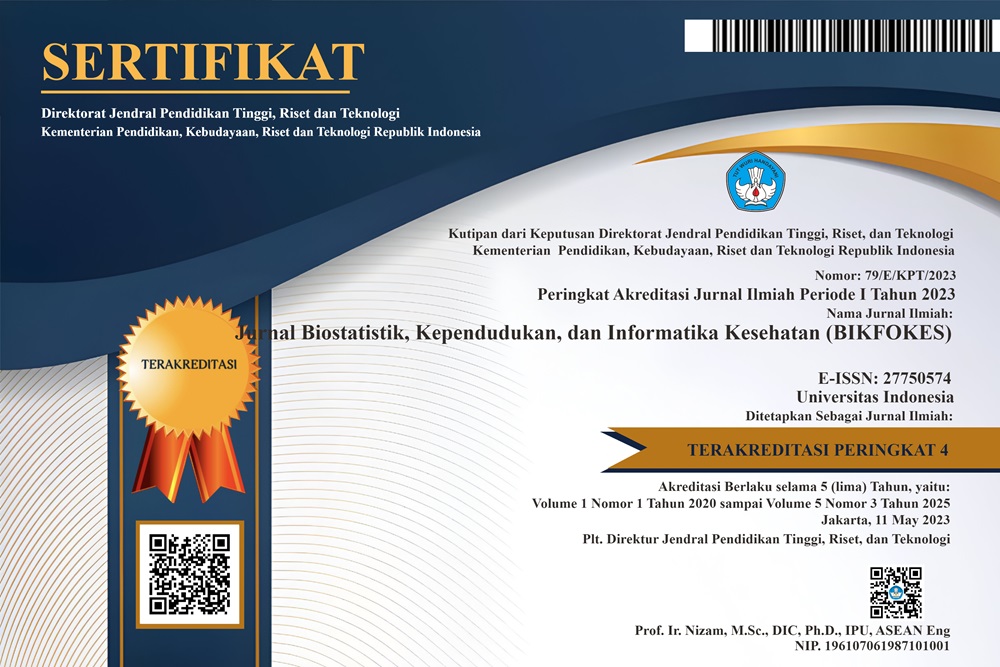Abstract
Telemedicine has become a new paradigm in the world of health since its popular use to assist the Ministry of Health in monitoring self-isolating patients during the COVID-19 pandemic. This study aims to analyze service quality variables related to user satisfaction with telemedicine services during COVID-19 self-isolation among students in FPH UI. This research is quantitative research with a cross-sectional approach. The results show that the platform most widely used for telemedicine services during the COVID-19 pandemic was platform H by 25 people. The average satisfaction of telemedicine users during self-isolation tends to be high, namely 3.8 with the lowest value being 2.3 (SD=0.534). Service quality and user satisfaction are all positively correlated with weak to strong correlation levels, namely responsiveness (r=0.306), service reliability (r=0.598), information quality (r=0.490), empathy (r=0.509), ease of service (r=0.633), perceived usefulness (r=0.486). The quality improvement factor is based on high satisfaction in easier appointment registration, savings in out-of-pocket costs for travel and queuing time at health services. However, holistic health and regulatory services are needed to address user data security threats.
References
1. Rumah Sakit Akademik Universitas Gadjah Mada. Panduan Isolasi Mandiri. Yogyakarta: Rumah Sakit Akademik Universitas Gadjah Mada; 2020.
2. WHO. Indonesia: WHO Coronavirus Disease (COVID-19) Dashboard With Vaccination Data [Internet]. WHO. 2023. Available from: https://data.who.int/dashboards/covid19/vaccines?m49=360&n=c
3. Lestari S, Gozali D. Narrative Review: Telemedicine Dan Implementasinya Dalam Membantu Perawatan Pasien Coronavirus Disease 2019. Farmaka. 2021;19(3):63–72.
4. Wulandari A, Febrianti F. Covid-19 Self-Isolation Telemedicine Service User Satisfaction in Indonesia. Al-Sihah: The Public Health Science Journal. 2022;142–52.
5. Kim NY. Social and Health Beliefs Related to College Students’ COVID-19 Preventive Behavior. Healthcare. 2023;11(13):1869.
6. Aneja J, Goyal T, Verma M, Kaur G, Mirza M, Gupta S. Client satisfaction with telemedicine services during COVID-19 pandemic: A cross-sectional survey from a teaching institute of North India. J Family Med Prim Care. 2022;11(9):5187.
7. Andrianto W, Athira AB. Telemedicine (Online Medical Services) Dalam Era New Normal Ditinjau Berdasarkan Hukum Kesehatan (Studi: Program Telemedicine Indonesia/Temenin Di Rumah Sakit Dr. Cipto Mangunkusumo). Jurnal Hukum & Pembangunan . 2022;52(1):220–50.
8. Hung M, Ocampo M, Raymond B, Mohajeri A, Lipsky MS. Telemedicine among Adults Living in America during the COVID-19 Pandemic. Int J Environ Res Public Health. 2023;20(9):5680.
9. Pogorzelska K, Chlabicz S. Patient Satisfaction with Telemedicine during the COVID-19 Pandemic—A Systematic Review. Int J Environ Res Public Health. 2022;19(10):6113.
10. Al-Samarraie H, Ghazal S, Alzahrani AI, Moody L. Telemedicine in Middle Eastern countries: Progress, barriers, and policy recommendations. Int J Med Inform. 2020;141:104232.
11. Satin AM, Shenoy K, Sheha ED, Basques B, Schroeder GD, Vaccaro AR, et al. Spine Patient Satisfaction With Telemedicine During the COVID-19 Pandemic: A Cross-Sectional Study. Global Spine J. 2022;12(5):812–9.
12. Huang JA, Hartanti IR, Colin MN, Pitaloka DA. Telemedicine and artificial intelligence to support self-isolation of COVID-19 patients: Recent updates and challenges. Digit Health. 2022;8:205520762211006.
13. Adnan ML, Pramaningtyas MD. Telemedicine Use During COVID-19 Pandemic : Prospects And Challenges. JIMKI: Jurnal Ilmiah Mahasiswa Kedokteran Indonesia. 2021;8(3):225–33.
Bahasa Abstract
Telemedicine menjadi paradigma baru di dunia kesehatan semenjak penggunaanya yang populer untuk membantu Kementerian Kesehatan dalam monitor pasien isolasi mandiri pada pandemi COVID-19. Penelitian ini bertujuan untuk menganalisis variabel kualitas layanan yang berhubungan dengan kepuasan pengguna layanan telemedicine selama isolasi mandiri COVID-19 pada mahasiswa FKM Universitas Indonesia. Penelitian ini merupakan penelitian kuantitatif dengan pendekatan cross-sectional. Hasil menunjukkan platform yang paling banyak digunakan pada layanan telemedicine selama masa pandemi COVID-19 merupakan platform H sebanyak 25 orang, rata-rata kepuasan pengguna telemedicine selama isolasi mandiri cenderung tinggi yaitu 3.8 dengan nilai terendah adalah 2.3 (SD=0.534). Kualitas layanan pada kepuasan pengguna semua berkorelasi positif dengan tingkat korelasi lemah sampai kuat yaitu daya tanggap (r=0.306), keandalan layanan (r=0.598), kualitas informasi (r=0.490), empati (r=0.509), kemudahan layanan (r=0.633), kegunaan yang dirasakan (r=0.486). Faktor peningkatan kualitas didasari dari tingginya kepuasan dalam pendaftaran janji yang lebih mudah, penghematan biaya out-of pocket untuk perjalanan dan waktu antri di layanan kesehatan. Meskipun begitu diperlukan layanan holistik kesehatan dan regulasi menangani ancaman keamanan data pengguna.
Recommended Citation
Mulyaningrum, Fathiya Nissa and Raihanny, Nadya
(2024)
"Analysis of User Satisfaction of Telemedicine Services During COVID-19 Self-Isolation among FPH Students at the Universitas Indonesia,"
Jurnal Biostatistik, Kependudukan, dan Informatika Kesehatan: Vol. 4:
No.
2, Article 2.
DOI: 10.7454/bikfokes.v4i2.1056
Available at:
https://scholarhub.ui.ac.id/bikfokes/vol4/iss2/2


